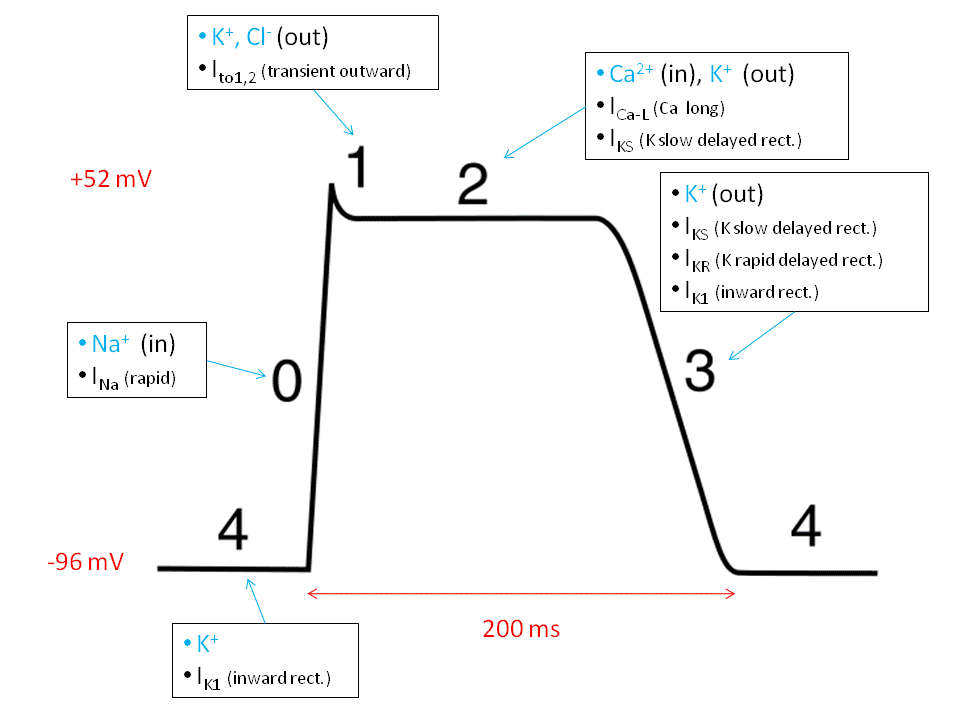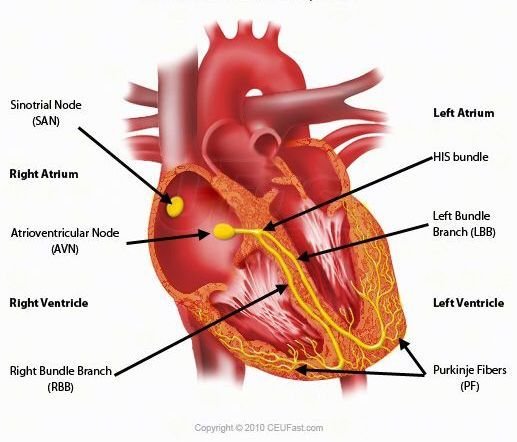A human heart will beat around 3 billion times in an average lifetime. The heart works continuously from birth till death, unlike many other muscles which require regular rest to prevent fatigue. Curiously, the heart will continue to beat outside the body, given sufficient nutrients and the correct conditions.

How does your heart actually beat?
It is all down to action potentials. Cardiac (heart) action potentials follow a very similar principle to those of nerves, which are detailed in this previous post. The distinguishing feature of cardiac action potentials is a plateau phase. This is shown in figure 1 below.

figure 1. Cardiac action potential
Phase 0 = depolarisation. Voltage gated Na+ channels open and Na+ moves from outside the cell to inside the cell down its concentration gradient making the voltage positive
Phase 1 = initial repolarisation. Voltage gated K+ and Cl- channels open. Both K+ and Cl- move out of the cell.
Phase 2 = plateau phase. Ca2+ channels open. This causes Ca2+ to move down its concentration gradient into the cell and prevent the membrane potential becoming negative for a brief period, thus causing the plateau.
Phase 3 = repolarisation. Ca2+ channels close and repolarisation continues
Phase 4 = resting potential. This is described in excruciating detail in a previous post.
But, how does this action potential translate into heartbeats?
The depolarisation phase of the action potential causes contraction of the cardiac muscle. Ingeniously, cardiac muscles are electrically connected through gap junctions (we don’t need to bother ourselves with how they work), which allow cardiac muscle to contract synchronously as a single unit.
How does the heart beat in time?
This is the final question that we need to answer. Since we have already seen that the heart can beat in time outside of the body, there must be something within the heart ensuring that the each part of the heart beats at the correct moment. This is conveniently named a pacemaker.
The primary pacemaker of the heart is known as the sinoatrial node (SAN), pictured in figure 2 below.

figure 2. Cardiac conduction system
The SAN is a cluster of cells located in the right atrium. It generates action potentials at regular intervals meaning the SAN directly controls heartrate. Each action potential generated by the SAN correlates to a single heart beat.
From the animation above, it is clear that the entire heart does not beat simultaneously. The atria must contract before the ventricles to allow blood to be pumped from the atria to the ventricles prior to the ejection of blood from the heart. If the SAN existed in solitude this would not be able to occur. Luckily, this problem is overcome by the atrioventricular node (AVN), shown in figure 2.
The AVN acts to delay the wave of depolarisation sweeping through the heart before it enters the ventricles. This allows the atria to contract before the ventricles, and thus the problem has been conquered. The wave of depolarisation then spreads through the Bundle of His down into the Purkinje fibres of the heart (shown in figure 2), to give the heart that characteristic beat depicted in the first animation. The path of the wave of depolarisation moving through the heart is indicated in the animation below.

The pacemaker ability of the heart is what makes cardiac muscles so unique. It is this ability which allows heart transplants to occur without the need to give the heart additional nervous connection when entering a donor body.
What if the pacemaker goes wrong?
If the heart loses all pacemaker ability, then it will not be able to beat in the correct time or with the correct synchronicity. In short, you will die. Fortunately, external pacemakers can be inserted into the heart takeover the role of the failed SAN. This is achieved through surgery, with two wires being inserted into the chambers of the heart.

figure 3. An artificial pacemaker
References:
Calculation for number of heartbeats in a lifetime
https://en.wikipedia.org/wiki/Ventricular_action_potential
http://www.cvphysiology.com/Arrhythmias/A004
https://www.bhf.org.uk/heart-health/treatments/pacemakers
https://en.wikipedia.org/wiki/Artificial_cardiac_pacemaker
Gifs
should know everybody...
"Our Heart"
Interesting. The heart is an amazing organ.
It certainly is!
Its the continuous stretching and contraction of muscles due to which heart does not get fatigue ever....I read it in my secondary school books
Well done on an amazing post. Learned quit a lot.
Thank you, much appreciated!